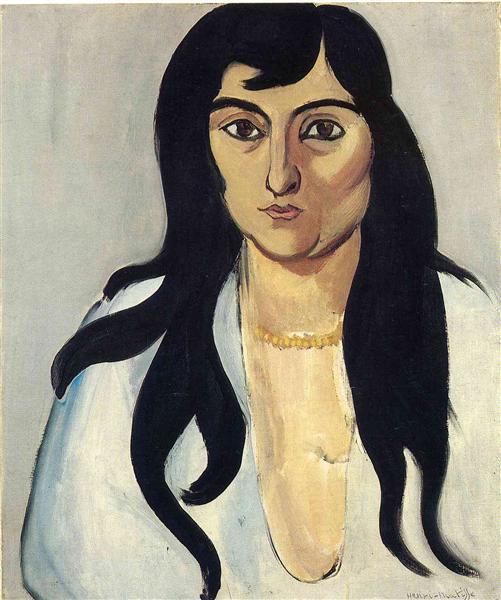Description
Henri Matisse, one of the most prominent names in Fauvism, offers us in 1916 a work that showcases both his mastery in the use of color and his sensitivity in portraiture. "Laurette with Long Locks" is framed in an intense period of artistic production, where the Italian model Laurette, with her expressive presence, becomes a recurring motif in his creations. This work, with its dimensions of 51x60 cm, captures the viewer's gaze thanks to its vibrant color palette and harmonious composition.
In "Laurette with Long Locks," Matisse presents us with a serene and contemplative female figure, seated in a chair, who bursts into the pictorial space with a mix of melancholy and dignity. Her long dark hair, practically the protagonist of the scene, falls over her chest in orderly cascades of locks, further highlighted by the contrast with the whiteness of her dress and the simplicity of the background. Matisse, true to his style, does not adhere to realistic representation; rather, he uses broad swathes of color to model the figure, composing an almost dreamlike atmosphere with greens, purples, and oranges.
Laurette's pose is a testament to Matisse's ability to capture the essence of his models with few but powerful details. The relaxed posture and slightly inclined face speak of an introspection that transcends mere physical appearance. The background, although ostensibly simple, displays subtle complexity by maintaining cool and controlled tones that frame Laurette without distracting attention from her central figure. It is a perfect balance between the figure and the space that contains it, a hallmark of Matisse's mature style.
The use of color in this work cannot go unnoticed. Matisse, in full command of his palette, opts for a predominant green that envelops Laurette, providing a unique freshness and vitality. This chromatic choice resonates with the principles of Fauvism, which sought to liberate color from descriptive function to make it an expressive medium in itself. The combination of oranges and purples in her flower crown and the chair's backrest, along with the warm tone of her skin, create a contrast that adds depth and dynamism to the painting.
In terms of technique, Matisse employs a confident and decisive stroke, with brushstrokes that, although they appear simple, reveal great complexity when observed more closely. Firm lines and soft contours juxtapose to create a sense of volume and three-dimensionality without resorting to detailed modeling. It is a balance between form and color that manages to convey the essence of the figure with admirable economy of elements.
To contextualize this work, it is useful to recall other representations of Laurette by Matisse, where she is seen in various poses and with different expressions. These paintings not only offer an ethereal aesthetic quality but are also an introspection into the model's psychology and the painter's evolving style. "Laurette with Long Locks" thus stands at the threshold between intimate portraiture and formal experimentation, presenting an artistic synthesis of great depth.
Ultimately, "Laurette with Long Locks" is a testament to Matisse's genius, his ability to transform the ordinary into something extraordinary through a singular pictorial language. This portrait not only captures the figure of Laurette but also crystallizes a moment of calm and reflection, inviting the viewer to immerse themselves in the personal and deeply colorful world of the artist. Thus, the painting transcends its time and place, ensuring its relevance and admiration in the history of art.

